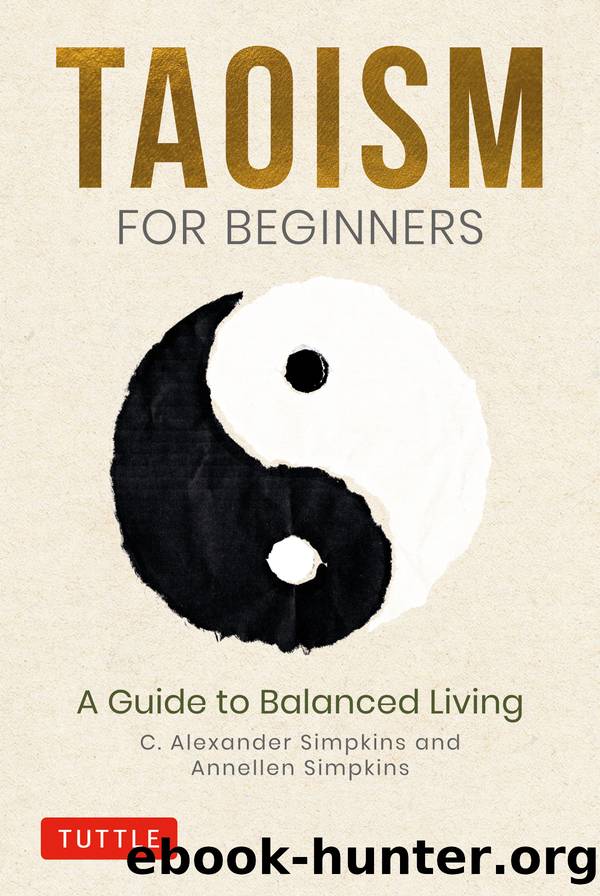Taoism for Beginners by C. Alexander Simpkins

Author:C. Alexander Simpkins
Language: eng
Format: epub
Publisher: Tuttle Publishing
12
Meditation: Deep Calm, Vital Energy
Attaining the utmost vacuity and earnestly observing quietness, while the ten thousand things all together are operating, I contemplate their return (to nothingness).
âTao Te Ching
Deep within the sea of consciousness we search for Tao. Meditation helps us navigate through the waters. Following the flowing circulation of chi as our compass, in tune with Tao, we can explore more deeply. Meditation can bring about clarity of thoughts, calming, along with greater vitality, sensitivity, flexibility, and resiliency. Taoists believe that the practice of meditation brings about healthier and happier living. Many traditional Taoist meditations are included in the next two chapters, along with modern adaptations to help you find your Way to Tao.
CALMING
Since Lao-tzu, Taoists have advocated quieting the mind. Although the early classical Taoists did not offer step-by-step instructions, they refer to meditation as holding the key to becoming receptive. Later Taoist movements formulated varied meditations for people to follow. This series of exercises will help you develop inner calm and clear perceptions the Taoist way, so that it seems to be happening without effort.
If you have any difficulty doing a meditation, take a break. Get up, walk around, and then try again. Or try again later, in bed before you fall asleep or when you first wake up in the morning. Remember that naturalness is central for Taoist meditation.
CALMING THE BODY
Mind and body are linked. One pathway to a tranquil mind is through the body. You can relax without forcing it by applying certain methods of meditation.
ALLOWING BODY RELAXATION
Find a place to meditate where you will not be distracted. Lie on the floor on your back with your arms resting at your sides. Raise your knees so that your feet are resting flat on the floor. Take a few moments and lie quietly. Let your attention wander to your body; notice where you are tight and where you are relaxed. Are you tensing any muscles? Notice how your body meets the floor. Are you pushing against it or are you allowing your muscles to let go to the floor, almost as if you are sinking or floating? At first, do not try to change anything. Simply notice what you feel and wait.
After several minutes your muscles may release excess tension. Wait for your body to respond on its own. Do not do anything except be open to the possibility that you could be more relaxed. People who carry excess muscle tension sometimes become so accustomed to it that they do not allow the possibility of change. Allow your muscles to be as relaxed as they want to be, but do not force relaxation. Be attentive to the feeling of willingness in your muscles. Increase the time spent in this meditation as much as is comfortable. Repeat this exercise at other times.
CALMING THINKING
Relaxing the body can bring about a quieting of the mindâas you may have experienced in the previous exercise. Inner calm can also be developed through mental exercises.
Tao always expresses itself as opposites. Thus stillness does not have to mean absence of movement or passivity.
Download
This site does not store any files on its server. We only index and link to content provided by other sites. Please contact the content providers to delete copyright contents if any and email us, we'll remove relevant links or contents immediately.
The remains of the day by Kazuo Ishiguro(8399)
Tools of Titans by Timothy Ferriss(7818)
Giovanni's Room by James Baldwin(6814)
The Black Swan by Nassim Nicholas Taleb(6772)
Inner Engineering: A Yogi's Guide to Joy by Sadhguru(6444)
The Way of Zen by Alan W. Watts(6290)
Asking the Right Questions: A Guide to Critical Thinking by M. Neil Browne & Stuart M. Keeley(5358)
The Power of Now: A Guide to Spiritual Enlightenment by Eckhart Tolle(5336)
The Six Wives Of Henry VIII (WOMEN IN HISTORY) by Fraser Antonia(5240)
Astrophysics for People in a Hurry by Neil DeGrasse Tyson(5003)
12 Rules for Life by Jordan B. Peterson(4165)
Housekeeping by Marilynne Robinson(4068)
The Ethical Slut by Janet W. Hardy(4041)
Skin in the Game by Nassim Nicholas Taleb(3973)
Double Down (Diary of a Wimpy Kid Book 11) by Jeff Kinney(3930)
Ikigai by Héctor García & Francesc Miralles(3899)
The Art of Happiness by The Dalai Lama(3850)
Skin in the Game: Hidden Asymmetries in Daily Life by Nassim Nicholas Taleb(3729)
Walking by Henry David Thoreau(3685)
